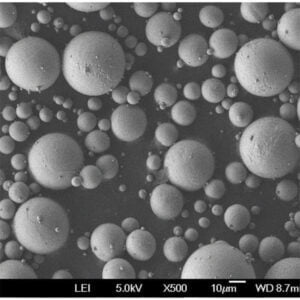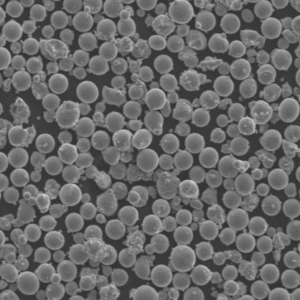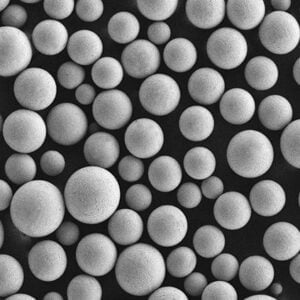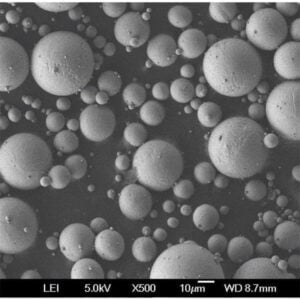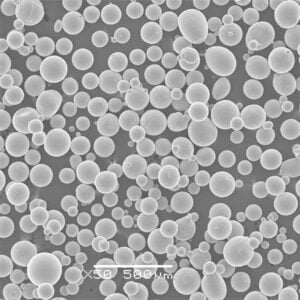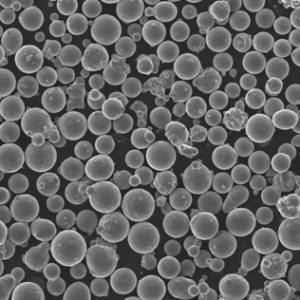球状チタン粉末
目次
概要
球状チタン粉末 は、球状の形態を持つように加工されたチタン金属粉末の一形態である。高い真球度、滑らかな表面、制御された粒度分布、良好な流動性が特徴です。
球状チタン粉末の主な特性と詳細には以下のものがある:
種類
- 純チタン粉末
- チタン合金粉末(Ti-6Al-4V、Ti-6Al-7Nbなど)
生産方法
- ガス噴霧
- プラズマ回転電極プロセス(PREP)
- 電極誘導溶融ガスアトマイズ(EIGA)
粒子径範囲
- 15-45ミクロン
- 45-100ミクロン
- 106~250ミクロン
一般的な用途
- 3Dプリンティングパウダー
- 金属射出成形
- 溶射
- チタン部品の製造
主な特徴
- 高い真球度 (>90%)
- 制御された粒度分布
- 良好な流動性
- 高純度
- 不規則な粉末に比べて表面積が小さい
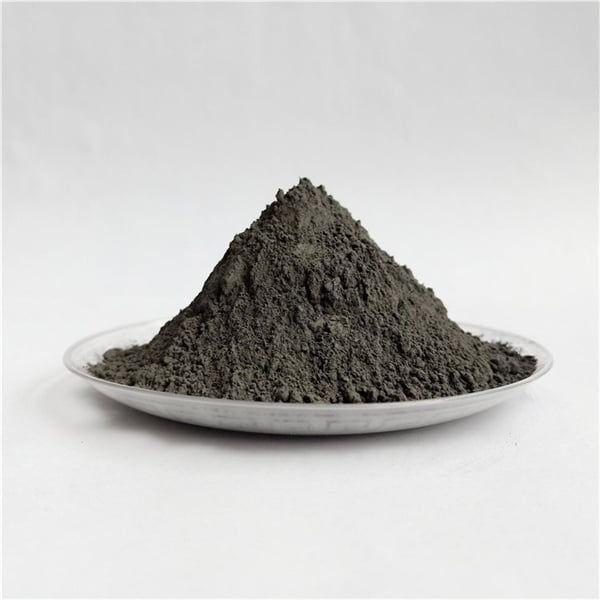
種類 球状チタン粉末
球状チタンパウダーには、組成に基づく2つの主なカテゴリーがあります:
表1: 球状チタン粉末の種類
| タイプ | 説明 |
|---|---|
| 純チタン | 99.5% 低酸素・低鉄レベルのチタン |
| チタン合金 | チタンとアルミニウムの複合+バナジウム、ニオブなど |
純チタンパウダー
純球状チタンパウダーは、少なくとも99.5%のチタンを含み、酸素と鉄のレベルは最大に制限されています。チタン合金の中で最も高いチタン含有量を誇ります。
典型的な組成:
- チタン:最低99.5%
- 酸素:最大2000ppm
- 鉄:最大3000ppm
高強度、低密度、耐食性など、純チタンに近い特性を持つ。高い化学純度が必要な場合に使用される。
チタン合金粉末
最も一般的なチタン合金粉末は、アルミニウムとバナジウムまたはニオブを添加したTi-6Al-4VとTi-6Al-7Nbです。モリブデン、ジルコニウム、スズなどの元素を含む他の合金も製造されています。
合金の利点:
- 強さの向上
- より高い温度能力
- 耐食性の向上
合金粉末は、純チタン粉末を超える応用範囲を広げます。
球状粉末の製造方法
制御された粒子径を持つ球状チタン粉末を製造するために、様々なガスアトマイズ技術が商業的に使用されている:
表2: 球状チタン粉末の製造プロセス
| 方法 | 原則 | 粒子径 |
|---|---|---|
| ガス噴霧 | ガスジェットによる溶融流の分解 | 15-106 μm |
| プラズマ回転電極(PREP) | 溶融金属の遠心分解 | 15-45 μm |
| 電極誘導ガスアトマイズ(EIGA) | 誘導溶解 + ガスアトマイズ | 15-250 μm |
代表的な生産サイズ
ガスアトマイズはアルゴンや窒素のような高速の不活性ガスジェットを使用し、チタン金属の溶融ストリームを微細な液滴に分解します。これにより、表面張力効果の結果、滑らかな表面を持つ球状の粒子が生成されます。
PREPとEIGAは、制御性を高め、粒度分布を狭くし、形状を最適化するバリエーションです。
仕様
球状チタン粉末 は、粒径によって分類された様々なサイズカットがあります。一般的なメッシュベースのサイズ範囲は以下の通り:
表3: 粒度仕様
| サイズ分類 | メッシュ範囲 | 粒子径 |
|---|---|---|
| 小さい | -325メッシュ | <45 μm |
| ミディアム | 140-325メッシュ | 45-100 μm |
| 大型 | +100メッシュ | >106 μm |
粉体を特定するために使用されるその他のパラメータ:
- 真球度: >90%は粒子の球形度を示す
- タップ密度: 2.2-3.5 g/cm3は充填密度
- ハウズナー比: <1.25は流動性を示す
- 見かけ密度: 組成に基づく範囲
- 流量: 漏斗を通る質量流量の測定
粉体の規格にはASTM B819、ASTM F3049、EN 10204/3.1などがある。
の応用 球状チタン粉末
制御された粒度分布と球状形態は、チタン粉末の用途を拡大する特定の利点を提供する:
表4: 球状チタン粉末の代表的な用途
| エリア | メリット |
|---|---|
| 3Dプリンティング | 優れた流動性、積層造形用充填密度 |
| 金属射出成形 | 複雑なネットシェイプ部品の製作が可能 |
| 溶射 | コーティング密度と蒸着効率を向上 |
| 粉末冶金 | ファスナー、ギアなどのチタン部品の製造を容易にする |
| バイオメディカル | インプラント用表面コーティングの特性向上 |
| 航空宇宙 | 熱間静水圧プレスによるジェットエンジン部品の補修に使用 |
球状粉末の主な利点は、不規則な粉末よりも自動材料ハンドリングが容易であることです。これにより、チタンコンポーネントを正味の形状に近い形で製造することができます。
サプライヤーと価格
球状チタン金属粉末は様々な大手メーカーから販売されています:
表5:主な球状チタン粉末サプライヤー
| 会社概要 | 生産方法 |
|---|---|
| エーピーアンドシー | ガス噴霧 |
| カーペンター・テクノロジー | 電極誘導溶解 |
| サンドビック | プラズマ霧化 |
| TLSテクニーク | ガス噴霧 |
| テクナ | プラズマ誘導 |
価格見積もり:
- 純チタン:$50-100/kg
- チタン合金kgあたり$70-150
価格は、注文量、パウダーグレード、粒度範囲、および市場の需要と供給の経済性によって異なります。
球状チタンパウダーの長所と短所
表6: メリットとデメリットの比較
| メリット | デメリット |
|---|---|
| 自動化のための優れた流動性 | 他の形式より高いコスト |
| 高い充填密度 | 限られた超大型サイズしか入手できない |
| 制御された粒度分布 | 制御された不活性雰囲気が必要 |
| ニアネットシェイプ製造能力 | 高温での反応性 |
| 他のパウダーとのブレンドが良い | 粉塵爆発の危険性を管理しなければならない |
| バルクに近い材料特性を実現 |
一方 球状チタン粉 はプロセスの柔軟性を高めることができるが、発火や爆発に対する取り扱い上の注意も必要となる。コストはスポンジ微粉のような他の形態よりも高い。
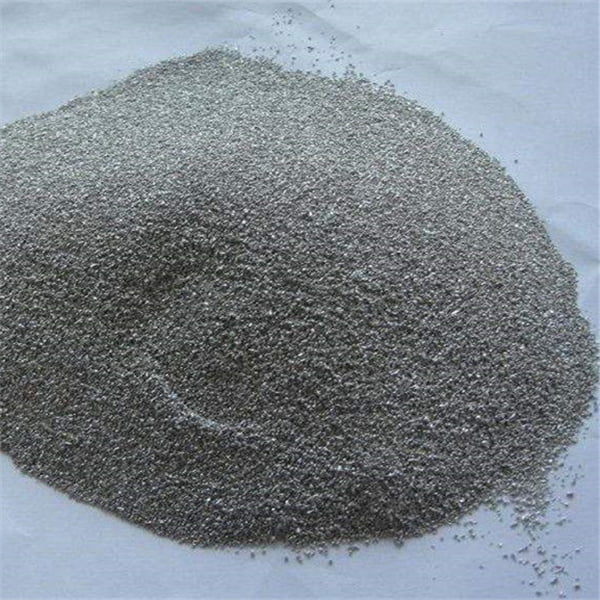
よくあるご質問
球状チタン粉末の一般的な純度はどのくらいですか?
純チタンパウダーの純度レベルは、ASTM規格による最低チタン含有量99.5%です。Ti-6Al-4Vのような合金の場合、チタンレベルは90%以上で、他の元素は特定の範囲になります。
アディティブ・マニュファクチャリングに最適なサイズ範囲は?
ほとんどのチタン粉末床溶融プロセスでは、理想的な粒子サイズの範囲は45~100ミクロンです。これより小さいサイズは流動性が悪く、これより大きいサイズは解像度に影響します。ASTM F3049のような規格が仕様を規定しています。
球形は印刷部品の特性に影響を与えるか?
はい、球状粒子は、より良い機械的特性につながる粒子間結合と、より高い密度の印刷をもたらします。部品はバルクチタンに近い特性を得ることができます。
球状チタン粉末の一般的な生産能力は?
球状チタン粉末の主要メーカーの生産能力は、年間数百トンから現在年間2000トン以上である。能力は、金属AMの成長に合わせて大幅に拡大すると予想される。
球状チタン粉末の価格はどのように決まるのですか?
価格は、粉末の組成、粒度範囲、製造方法、注文量、市場の状況によって異なります。小さいサイズ(<45μm)は、加工の難易度と需要が高いため、大きいサイズよりも20-30%高いのが一般的です。
結論
球状チタン粉末は、流動性、充填密度、および自動粉末加工における再現性の点で、他の形態のチタン粉末よりも明確な利点があります。これにより、優れた特性を持つネットシェイプに近い部品の製造が可能になります。
様々なガスアトマイズ技術により、粉末床融合技術に依存する金属3Dプリンティングのような製造方法のために、チタン合金のテーラーメイド製造と粒度分布が可能になる。
価格の上昇にもかかわらず、球状形態の利点は、従来の加工を越えてチタン金属の用途を拡大するために、産業界全体で採用が増加しています。更なる特性向上のため、粒度分布や合金組成を改善する進歩が続いています。
シェアする
MET3DP Technology Co., LTDは、中国青島に本社を置く積層造形ソリューションのリーディングプロバイダーです。弊社は3Dプリンティング装置と工業用途の高性能金属粉末を専門としています。
関連記事
Met3DPについて
最新情報
製品

3Dプリンティングと積層造形用金属粉末






